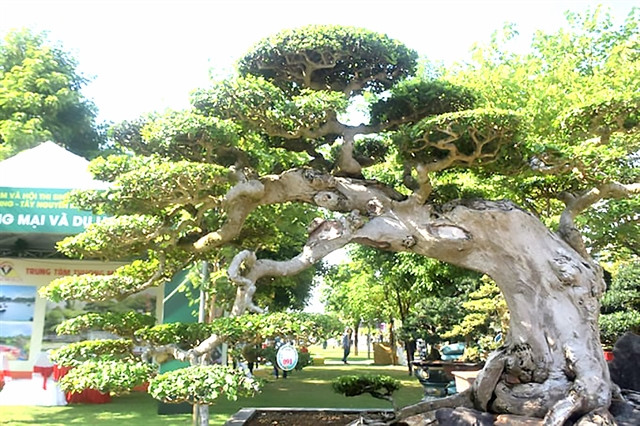 |
| A bonsai tree from an artisan in An Nhơn Town is shown at a recent ornamental plant exhibition in Bình Định Province. — Photo courtesy of Bình Định Province's portal |
Cultivating ornamental plants may seem like a form of entertainment, but in reality, it has become a primary source of income in many rural areas.
As highlighted by Associate Professor Dr. Đặng Văn Đông, deputy director of the Fruit and Vegetable Research Institute, the ornamental plant industry in Việt Nam has seen rapid growth. This surge is attributed to the burgeoning desire for elaborate interior and exterior decoration in recent years.
The range of ornamental products is diversifying, including interior and exterior plants, bonsai, flowers, and even pet species such as dogs, cats, ornamental fish and birds.
As the ornamental plant industry gains popularity, the sectors involved in producing accessories and equipment related to ornamental plants also thrive.
In recent years, the ornamental plant industry in Việt Nam has seen increased attention in applying advanced techniques and technologies to care for, nurture, and shape ornamental plants.
"The evolution of ornamental plant production extends far beyond the mere supply of plants to the market. In this dynamic industry, each enthusiast has transformed into an artisan, engaging in the meticulous design and sculpting of plants to create unique products," Đông told Nông Nghiệp Việt Nam (Việt Nam Agriculture) newspaper.
Trần Đình Hòa, residing in Cát Tiên Town, Phù Cát District, Bình Định Province, was once hailed as the bonsai king of sanh (Ficus benjamina) tree.
According to him, those who enter the ornamental creature industry are usually led by a passion.
However, having passion alone is not enough. Continuous efforts along with learning and improving are essential for development in this trade.
A seemingly ordinary ornamental plant in the hands of a dedicated artisan can transform into a valuable masterpiece.
"Most individuals who enter the ornamental plant industry are driven by passion. However, those who own ornamental plants need to be knowledgeable about care and must possess the patience required to nurture their ornamental masterpieces, ensuring their vitality and maintaining a high level of aesthetic appeal," Hòa said.
Hòa ventured into the world of ornamental plants at a young age, starting with the simple task of helping his father carry buckets of water to irrigate plants and assisting him in shaping ornamental trees.
After his father's passing, Hòa inherited his collection of ornamental plants, continuing his father's passion and achieving success.
In 1997, he participated in the first Ornamental Creature Exhibition in Bình Định Province.
During the time when sanh trees were more valuable than gold, he earned the title of the 'king of sanh.'
Despite the fluctuating market, he has persevered in his profession and expanded into more types of ornamental plants.
"I currently have around 400 ornamental plants. Cultivating ornamental plants originates from passion, but once transformed into artworks, it becomes an economically lucrative industry. People in rural areas participating in the ornamental plant industry can afford to build houses and support their children's university education. Despite the economic downturn in recent years and a significant decrease in the market demand for ornamental plants, my family still earns several hundred million đồng each year," said Hòa.
In An Nhơn Town, many farmers have become prosperous or even millionaires through the profession of growing yellow ochna blossom trees.
 |
| A unique masterpiece from the Hữu Khánh garden in Phước Lộc Commune, Tuy Phước District. — Photo nongnghiep.vn |
According to artisan Phan Văn Sáu, vice chairman of the Ornamental Creature Association in Nhơn An Commune, An Nhơn Town, the cultivation of yellow ochna blossom trees originated in Nhơn An Commune more than 40 years ago and quickly spread to other communes, involving thousands of households cultivating over two million pots of yellow ochna blossom trees on an area of 145 hectares.
Currently, Nhơn An Commune has expanded the area of yellow ochna blossom tree cultivation to 90 hectares with 400,000 trees, involving over 1,500 households.
Approximately 80 per cent of ochna blossom growers have applied advanced techniques in planting, caring, pest control, and flower induction, ensuring that the trees bloom precisely for the Lunar New Year.
Ochna trees have truly become a source of wealth for the people of Nhơn An, generating an annual income of VNĐ50 billion to VND60 billion. Compared to rice cultivation, growing ochna blossom trees brings farmers an income more than 10 times higher, providing employment for thousands of rural labourers.
"The increased income from ochna cultivation has significantly reduced the poverty rate in Nhơn An Commune, and it now stands at only 2 per cent," said Sáu.
Đông said that the evidence of the recent growth in the ornamental plant industry is apparent, but the implementation of the Government's decree on rural development linked to the ornamental plant sector still confronts numerous challenges.
There is a severe lack of investment in infrastructure, research and development funding, and brand promotion. Product quality and standardisation are constrained, and growers lack specialised knowledge and skills. In particular, the support policies are insufficient to effectively encourage the development of the ornamental plant sector.
"We hope that in the coming years, the ornamental plant industry will receive attention from the government, with supportive policies and investment to foster its development," Đông said. "Reducing complex procedures to facilitate entrepreneurship, encouraging research, and applying advanced methods and technologies in artwork care are crucial. Additionally, we need to promote the digitalisation and communication of ornamental plant information, build linkage models from production to product consumption, and focus on developing human resources and enhancing vocational training for sustainable development." — VNS